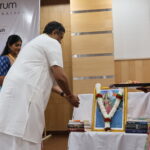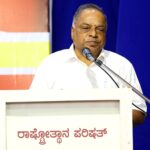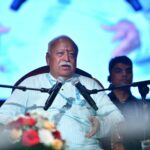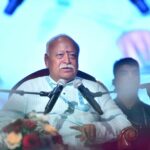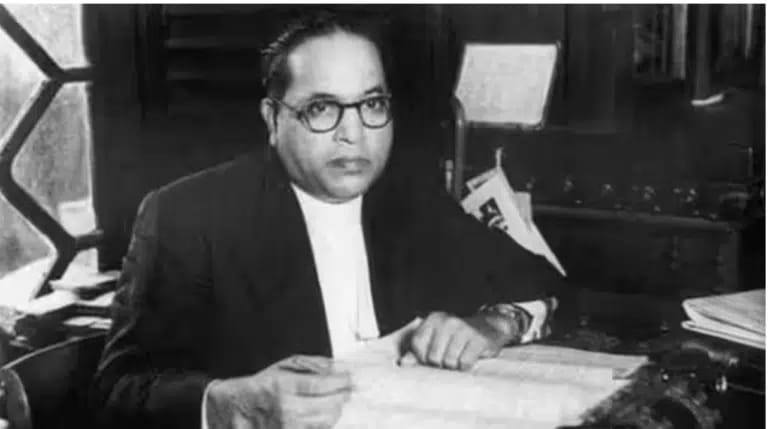
The article was originally published in Indian Express on October 14, 2023 as a part of Dr Ram Madhav’s column titled ‘Ram Rajya’.
Sixty-seven years ago, on October 14, 1956, just seven weeks before his demise, B R Ambedkar — architect of the Indian Constitution and leader of the Depressed Classes — took the life-changing decision to renounce Hinduism and convert to Buddhism. A revered Buddhist monk from Burma (Myanmar), Bhikkhu Chandramani, initiated Ambedkar, his wife and a few lakh people, who had gathered from all over the country, into Buddhism on that morning of the Hindu festival of Dussehra. The venue in Nagpur has since come to be recognised as Deekshabhoomi and is a major pilgrimage site for neo-Buddhists.
Ambedkar’s conversion was the culmination of a vow he took exactly 21 years earlier. On October 13, 1935, Ambedkar was at Yeola in Nashik district, Maharashtra, to address a conference of the Depressed Classes. In an emotional address that lasted for an hour and a half, Ambedkar told his audience of more than 10,000 that while he was born a Hindu because it was not in his hands, he wouldn’t want to live under the humiliating conditions of the religion. “I solemnly assure you that I will not die a Hindu,” he declared.
In an article in these columns two weeks ago on the occasion of the birth anniversary of Mahatma Gandhi, I wrote about the intense discussions Gandhi and Ambedkar had over the question of varna and jati (caste) in Hinduism. I stated that the Poona Pact, through which Gandhi was able to bring Ambedkar around to an agreement for the Depressed Classes to be given a political share in the governance as a part of the Hindu society, remained just a political deal. Ambedkar and Gandhi continued to drift away from each other after the Poona Pact. Their ideological differences kept growing and at one point in early 1946, Ambedkar himself told an audience in Sholapur that Gandhi had declined to meet him “saying that there was nothing common in their angles of vision”.

Coming just one year after the Poona Pact, Ambedkar’s declaration of leaving the Hindu religion rattled Gandhi. Describing Ambedkar as “high-souled” and “highly educated”, Gandhi urged him to reconsider the decision because “despite isolated events” untouchability was “on its last legs”. He also insisted that Ambedkar should examine “his ancestral religion” on its own merits and not through the weaknesses of its “unfaithful followers”.
Ambedkar disagreed with Gandhi on that fundamental premise. While Gandhi blamed the faithful, Ambedkar blamed the teachings of Hinduism. For him, as long as caste and varna existed, there was no freedom for “untouchables”. In a long speech he delivered in May 1936 at Dadar in Bombay, Ambedkar insisted that the struggle between the “Caste Hindus” and “untouchables” is a “permanent phenomenon” because “the religion which has placed you at the lowest level of the society itself is eternal”.
As regards Gandhi’s efforts at integrating the members of the Depressed Classes — whom he called “Harijans” — into the Congress fold, Ambedkar was categorical that it was a trap that the “untouchables” shouldn’t fall into.
Delivering an important speech at the All-India Depressed Classes Conference in Nagpur on July 18-19, 1942, Ambedkar explained the reasons for his opposition to Gandhi. By then, the Depressed Classes Conference had started attracting large crowds. There were more than 75,000 people in the audience at the Nagpur conference. Their numbers in the British Army and administration too witnessed a rise in the years after the Poona Pact. Ambedkar referred to this awakening but insisted that it was “not the result of Hindu charity” but “entirely the result of our own labour”.
Ambedkar argued that political power was critical for securing the rights of the Depressed Classes, without which “we will perish”. Of all the adverse forces in winning the political battle for the “untouchables”, Ambedkar found Gandhi to be “the most formidable force”. However, Ambedkar’s battle against varna and the caste system in Hinduism went beyond power politics. A landmark intervention in this regard was his 1936 book, Annihilation of Caste.
Annihilation of Caste was originally drafted as the text of a speech he was invited to deliver at the Jati Pati Todak Mandal’s event in Lahore. However, Ambedkar’s strong critique of the Vedas and other Hindu scriptures in the context of the chaturvarna system was seen by the organisers as too controversial and the event itself was eventually cancelled. Ambedkar then published the essay as a book.
Ambedkar called the caste system “a planned misfortune” and added, “I would be glad to take a leading part in the destruction of the caste system if the Hindus are willing to work in earnest towards that end, even if they had to forsake their kith and kin and their religious notions.” He firmly believed that caste cannot be overcome by inter-caste dining or marriages because it is a “mindset” and a “disease of mind”. He waited for two decades to see if the Hindus accepted his proposition of dismantling caste. Several so-called caste Hindus joined Ambedkar in conversion at Deekshabhoomi.
Justifying his conversion, Ambedkar described Buddhism as a revolt against the discriminatory Hindu social order. He insisted that liberty, equality and fraternity were not ideas that we borrowed from the French Revolution but the essence of the “teachings of my master, Buddha”.
As caste re-enters the political discourse of our country in a big way, the history of Ambedkar’s journey from the Poona Pact to Deekshabhoomi also returns in relevance. Ambedkar insisted that since the institution of caste had divine sanction, its rejection also must come from an appropriate religious authority in Hinduism. There was some progress in the late 1960s when the Hindu saints came together to declare that all Hindus were brothers and sisters.
Yet, instead of absolutely rejecting varna and caste as desired by Ambedkar, we, unfortunately, continue to fortify those very institutions for political expediency or out of religious orthodoxy


